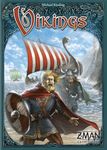- Publisher
- Rio Grande Games
- Published in
- 2007
- My Rating
- 8.75
- BGG Rating
- 6.88
- BGG Rank
- 610
- Players
- 2-4
- Ages
- 10+
- Duration
- 1:00
- Complexity
- 2.542 / 5
- Acquired
- September 2010
- Eager to Play
- No
- Plays
- 6
- Last Played
- July 21, 2013
- Time Spent
- 6:00
Vikings is strategic tile-based game where players spend gold to buy both a viking and an island tile, and place them in their tableau to their best advantage. The game board includes a score track, a round track, and the payment wheel; the payment wheel is one of the central mechanics of the game. The wheel has 12 slots, numbered 0 - 11, each corresponding with a location where a tile and viking combo will rest. The number of the slot determines the cost for that set. There are two types of tiles in the game, islands and ships, and six different types of vikings. Each player also receives a player base. The game plays over 6 rounds, then a final scoring round occurs and the victor is determined.
When the game is setup all the tiles are shuffled then arranged into stacks of 12 tiles, then placed on the round track. At the beginning of each round the next tile stack is removed from the round track and distributed around the payment wheel. Islands are start at 0 and work up to 11 while ships start at 11 and work down to 0. Finally 12 vikings are chosen from a cloth bag and arranged on the offered tiles, always in the same color order. Players take turns buying the tiles until there are no titles left to purchase. A player must buy a tile, and may buy any tile he can afford, the only exception being the tile priced at 0, which can only be purchased when no other vikings of the same color are available, or the player cannot afford any of the offered tiles. When the tile at 0 is purchased the wheel is rotated clockwise until another tile is worth 0. When a tile is purchased it is immediately placed in the player's play area; however, the tile must be orthogonally adjacent to another tile or the the player base. Any island tiles must be played correctly orientated, and the tile's edges must match those it is adjacent to (water to water and land to land), otherwise the tile is discarded from play. All ship tiles are played in the first row of the player's tableau.
Each viking color corresponds to a particular fashion of scoring in the game, though wile every tile will be played, not every viking will come into play. Each row in the player's tableau corresponds to one of the vikings, and if an island is placed in the same row as the viking that came with the tile, then the viking can be placed on the tile just played, otherwise he's set on the player's base. Vikings score when they are on islands, with the only exception being the boatsmen, who score vikings on the base.
The game has a fascinating depth of strategy, as players not only must choose which tiles they want, weighed against which vikings they want, they must also manage the payment wheel. Careful selection of the tile/viking combo will reward the player, and skillful management of the payment wheel can force an opponent to take a disadvantageous tile/viking set. Vikings is a marvelous game of strategy and dynamics.
Six plays
- July 21, 2013
- November 03, 2010
- October 23, 2010
- October 13, 2010
- September 16, 2010
- September 13, 2010
